Release highlights
We've just released Omada Identity Cloud update! What's new?
Cloud Application Gateway
With the July Cloud Update we introduce the CAG (Cloud Application Gateway) solution, which is a new and revolutionary improvement to connectivity and integration architecture. It is a modern and secure solution for connecting Omada Identity Cloud to on-premises and cloud-based deployments.
The CAG reduces complexity and potential security risks that that might be a part of the hybrid integration. The CAG solution supports the following core capabilities:
- Import and provisioning
- Schema discovery
- Test connection
Those capabilities are performed over a secure, outbound-only TLS connection. This eliminates the need to configure inbound firewall access, which is often disallowed in enterprise environments.
Improved security is of a highest importance, meaning that the CAG relies on the client-side key management. The encryption keys and sensitive secrets are under full customer control at all times. It is also never stored and transmitted through Omada systems.
The CAG solution can be deployed on Windows hosts.
Paired with the automated over-the-air (OTA) updates, CAG simplifies patch management and reduces the administrative overhead typically required to keep integration components secure and up to date.
Key characteristics
| Property | Description |
|---|---|
| Network configuration | Outbound-only TLS; no inbound rules or public IPs required. |
| Encryption & Key Handling | Customer-retained encryption keys; zero-knowledge architecture. |
| Deployment methods | Containerized or Windows-hosted options supported. |
| Update management | OTA updates for security and version control. |
For guidance on how to enable or migrate to the CAG solution, contact the Omada Support.
For more information, go to Cloud Application Gateway documentation.
UI and UX
We have introduced the following improvements:
-
When an access request is rejected and the approver has added a comment with the reason for the rejection, the requester can now see the comment.
 note
noteTo make the comment mandatory (and visible to the requester), enable a new customer setting
ApprovalRejectionReasonRequiredin the Standard Application category. When set to true, users need to enter comments for each rejected item, otherwise they won't be able to submit them. -
In the access approval process, rows can now be grouped either by identities (the default option) or by resources, which gives the approver a better overview of the assignees and resources.
To group by identities or resources, select the ellipsis icon (three dots) next to Identity or Resource, and select Group by Identity or Group by Resource. For more information on enabling and disabling the grouping, see the Row grouping section of Access approval.
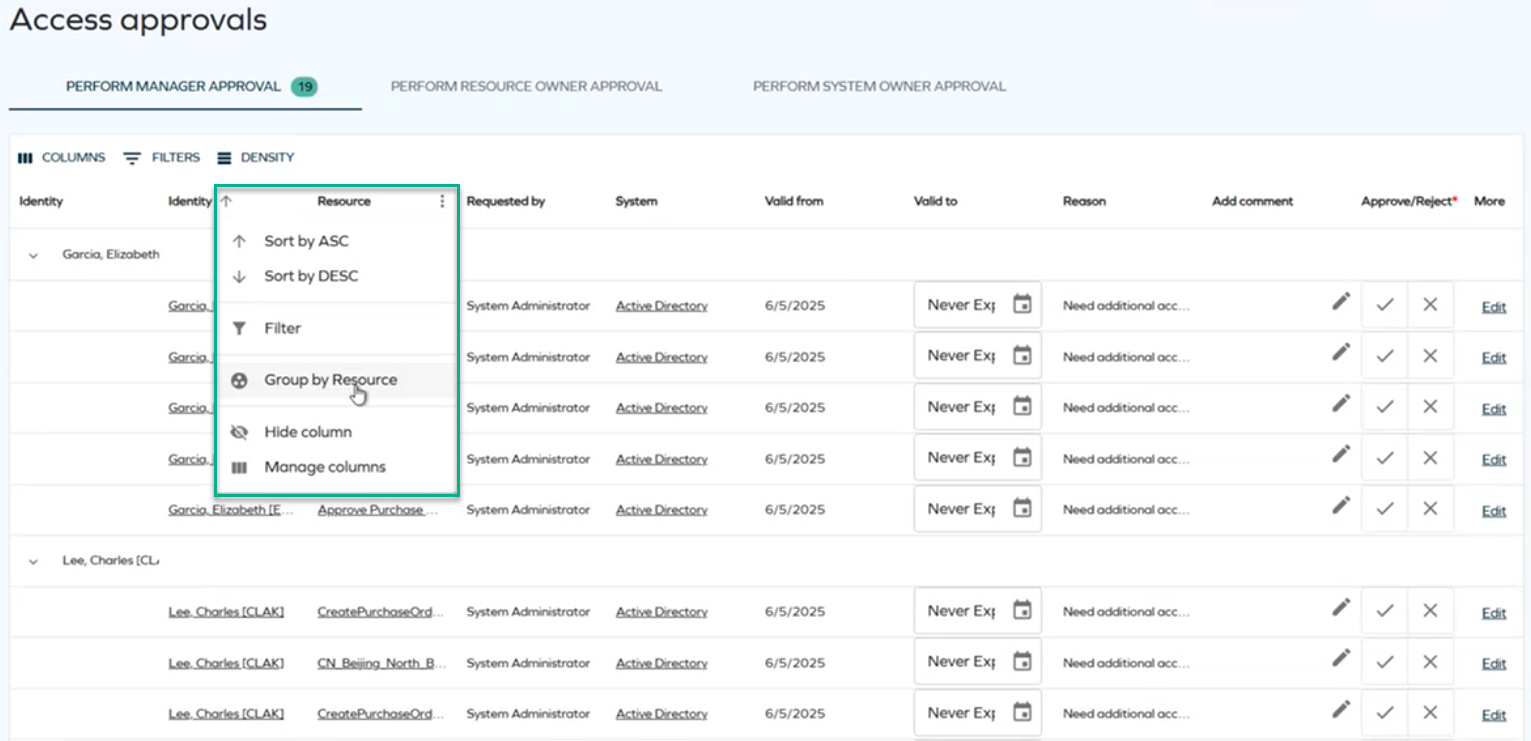
-
Before, the approver was only able to see the new valid to date of the access request, which did not inform them if it was the first access request or an access extension request. Now, if a user submits an extension request, the approver will see both the original and new valid to date.

-
While reviewing requests sent for approval, you can now filter them by request types (access extension or access request). This way, you can work separately on those two types of requests and have a better insight into both of them. To do that, on the Access approvals page, select Filters and choose Request type from the drop-down. Then, select Request access or Extend access. See Access approvals for more information.
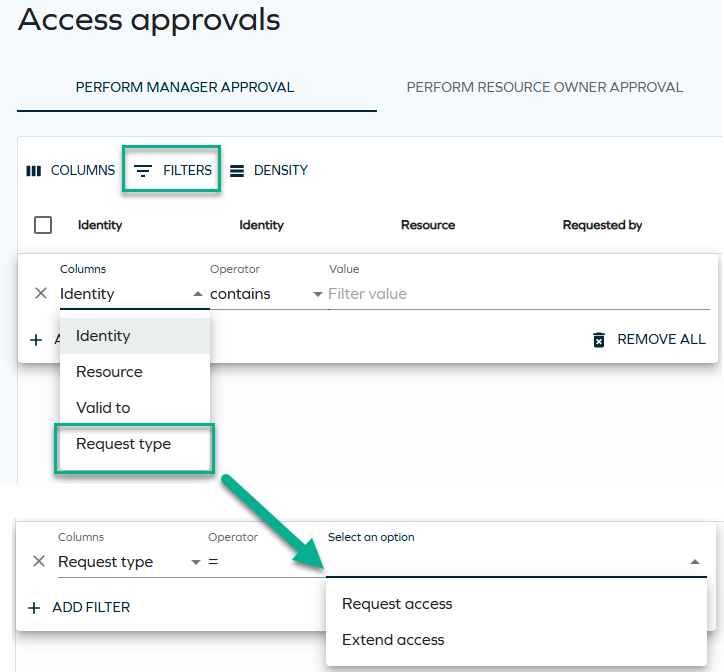
-
We have enabled easy navigation from user groups to resources. You can now click Resource while viewing user groups.

-
Various optimizations and improvements were introduced to provide better readability and UX for forms (in the new UI).
-
In the main left-side menu, the counter badge for the Tasks item now shows the total number of tasks pending, including the pending approvals.
-
In the Access view (in the list of submitted requests), the approval state now includes the comment from the approver.
-
In the Approvals view, when a request is rejected, you can now make the comment field mandatory. You can achieve this through enabling the IsRevokeAssignmentCommentMandatory customer setting (it is disabled by default). If the comment is set to mandatory in the approval survey, it will be mandatory when both rejecting and approving a request.
Revoking resource assignments for multiple identities
We have added an option to revoke resource assignments for multiple identities at once. In the Identities view, you can now select more than one identity and then, in the top right corner, click the ellipsis (three dots) > Access Rights. A side panel with details will let you perform a quick review before the revoke. See Revoking assignments (multiple identities) for details.
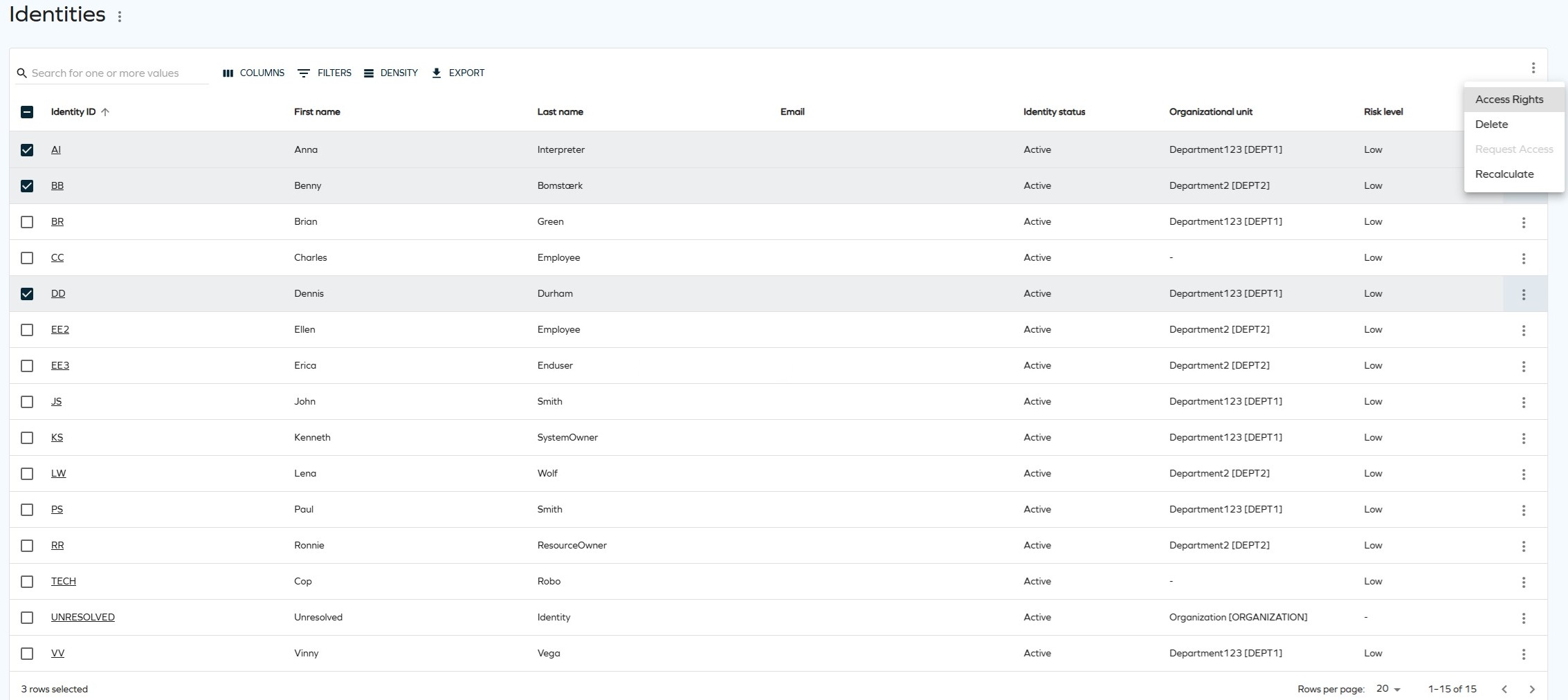
To allow users to revoke multiple assignments at once, change the Allow mass revoke of resource assignments (key: AllowMassRevoke) customer setting value to True. See Customer settings - User Interface for details. Otherwise, users will be able to revoke one assignment per action only.
Clickable columns in the Access view - displaying additional information
In the Access view (after navigating to Access from the main menu on the left in Omada Identity), the Access for and Resource columns are now clickable. An additional side panel is displayed, presenting more information about the data object in the read-only mode.
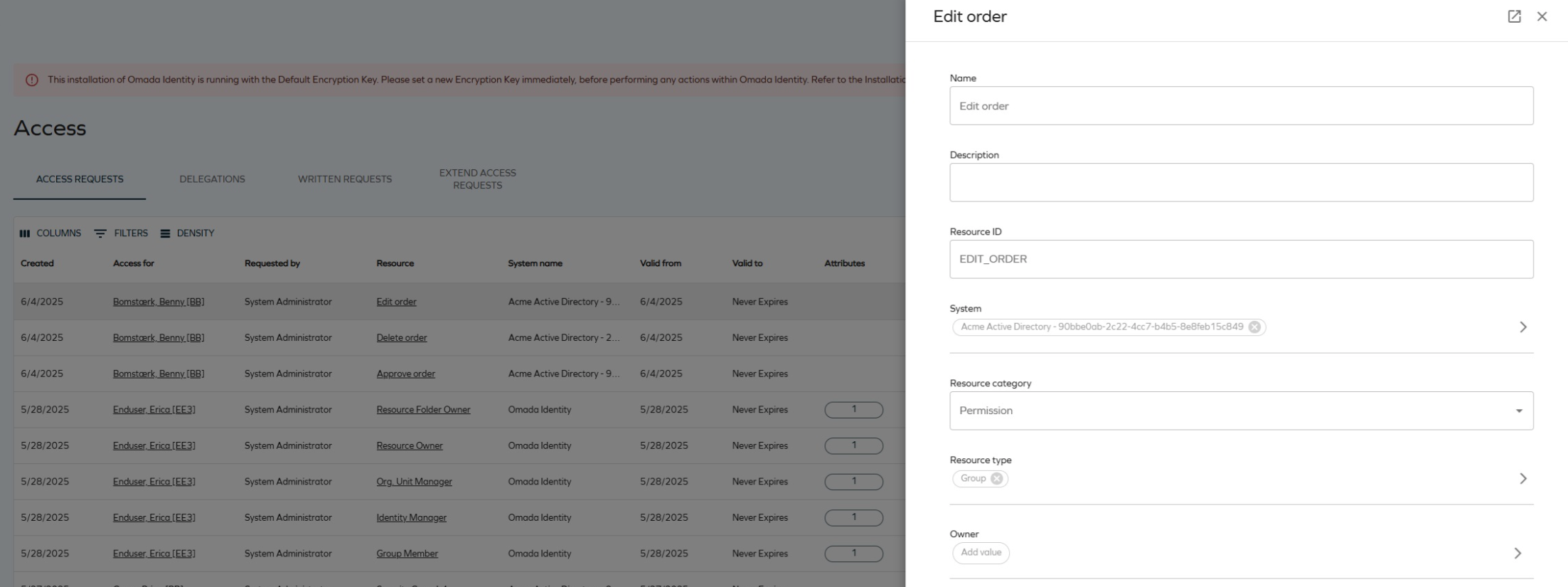
Surveys
Survey complete post-action handler
A new post-action handler (PAH) called SurveyCompletePostActionHandler has been implemented, which allows defining a property-value dictionary that is automatically applied to survey objects when a survey is closed by a system user.
This streamlines survey lifecycle management by enabling automatic tagging or classification, improving data consistency and reducing manual administrative effort.
For more information, see Survey templates - post actions.
Connectors
AWS connectivity package
We introduced a new connectivity package for AWS that supports governing and managing AWS IAM API environments. See AWS for details.
PostgreSQL support (generic database connector)
We have added support for data provisioning for PostgreSQL using the SQL Query Collector. See Generic SQL connector - data provisioning for details.
Extensions.GetValue and Extensions.SidToHex functions
You can now use the Extensions.GetValue and Extensions.SidToHex functions for all connectors (for environments running on July 2025 Cloud Update and Horizons). See Information, procedures, and tips applicable to all collectors for details.
Role and Policy Engine
Improvements to queuing methods
As part of our efforts to enhance RoPE performance, we have improved the speed of RoPE calculations.
Improved performance of resource hierarchy
This release introduces a new customer setting, Maintain resource parent child relation in RoPE DB, which improves the performance of resource hierarchy loading by populating the resource parent-child relation into the ResourceParentChild table.
This change significantly reduces database load and improves scalability for environments with complex resource hierarchies.
For more information, refer to Customer settings – Role and Policy Engine.
Access to Event Log
We have implemented access authorization for the Event Log (applicable to Omada Identity Cloud only). As part of this change, a new authorization element named Event Log has been added. The System Administrator and Operation Administrator roles have been granted access to this element.
Omada Identity Analytics
Access Navigator dashboard
Dashboards in Omada Identity Analytics now support a deeper understanding of customer’s data without having to create a report. New jump-to dashboards are available in the Access Navigator, including:
- Identity Change Log
- Accounts on Date
- Accounts Log for Identity
- Assignments in Period
- Assignments Change Log
For more information on this dashboard, see Access Navigator.
Data Quality dashboard
The Data Quality dashboard now supports analytics on additional reports:
- Accounts pending deprovisioning
- Accounts recently unused
- Accounts without owner
- Resource assignments pending deprovisioning
- Resources without owner
See Data Quality for the full documentation on this dashboard.
Report Generator dashboard
The Report Generator dashboard has been refreshed with a new layout and structure: the Data fields and Metrics widgets are now combined to make the dashboard easier to use. See Report Generator for full documentation.
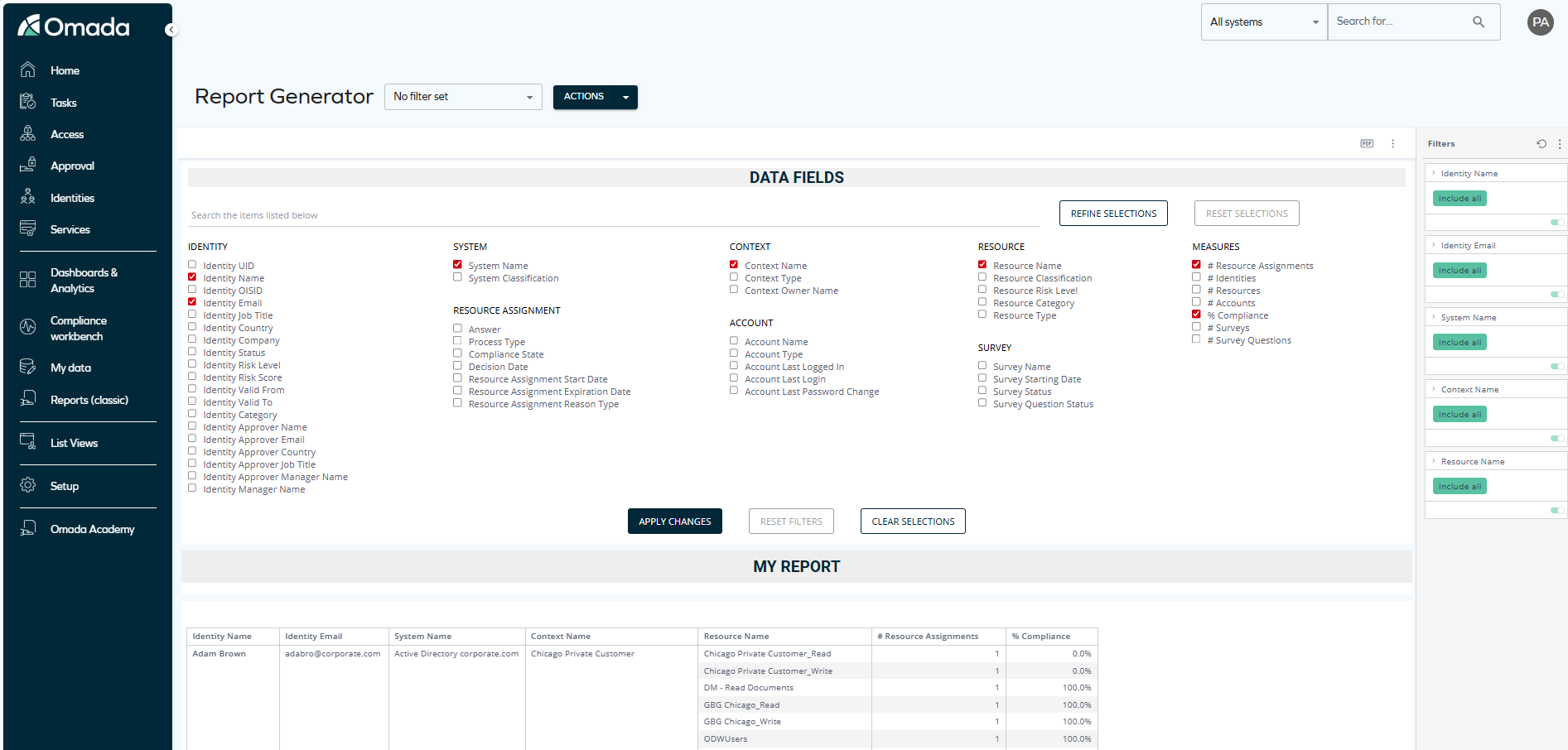
Cloud Management Portal
Logging level configuration
We have introduced a setting in the environment configuration, allowing to adjust logging level for the logging target. It provides a possibility to connect and filter the information sent to your logging system.
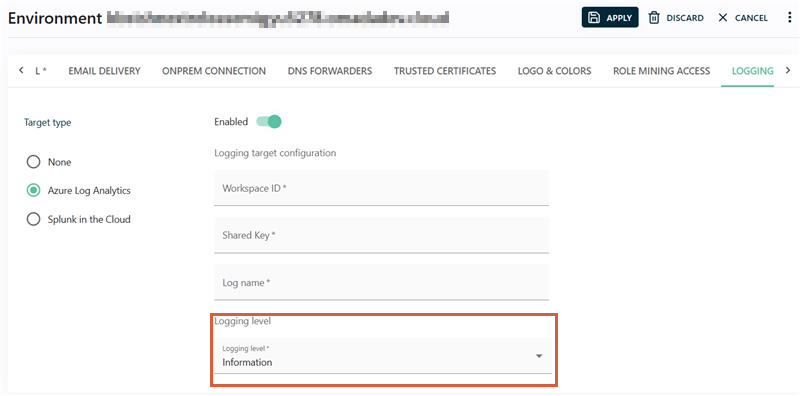
When setting the logging level, you can choose from the following options:
| Level | Use Case | Severity |
|---|---|---|
| Trace | Provides detailed internal diagnostics | lowest |
| Debug | Contains debugging info | low |
| Information | Provides normal app flow information | medium |
| Warning | Provides information about unexpected but non-breaking events | medium |
| Error | Provides information about recoverable failure events | high |
| Critical | Provides information about unrecoverable failure events | high |
Documentation
REST connectivity - practical examples
We added a new subsection that covers practical examples for REST connectivity (a comprehensive configuration and usage examples for anchor property, ResultValuesJsonPath, multivalue property handling, and other). See REST - practical examples for details.